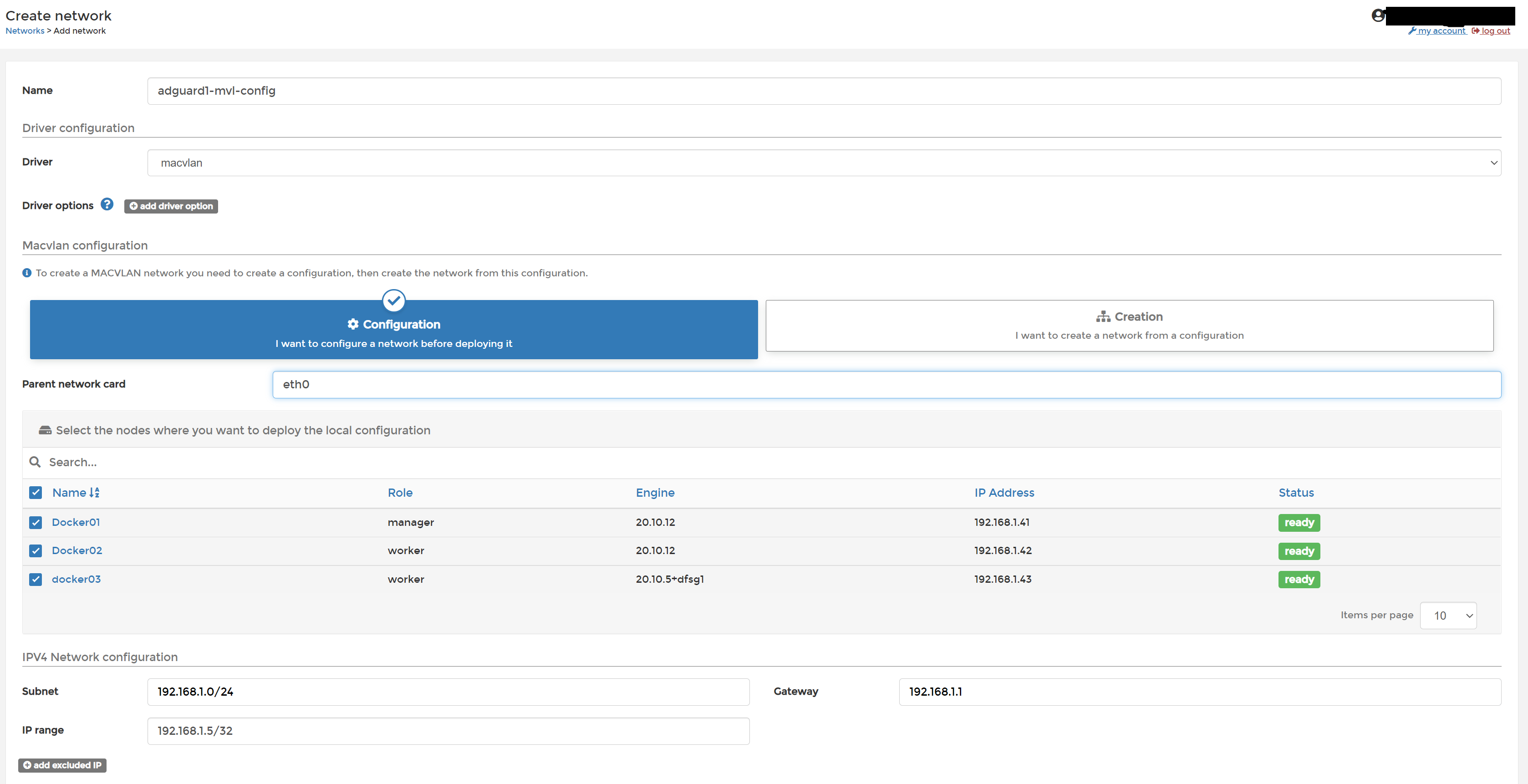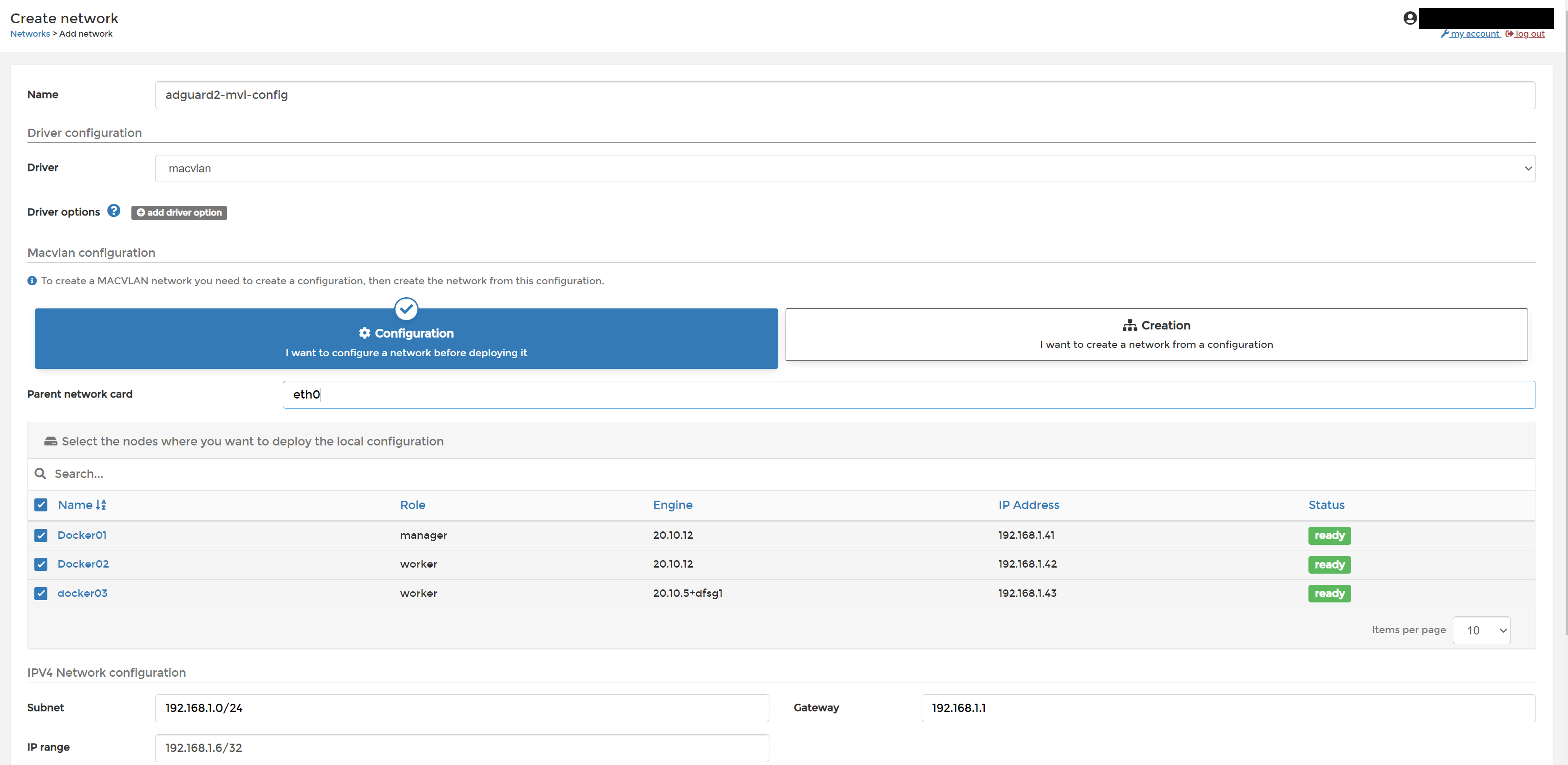UPDATED 9/2/2023 - here we are a few years later, adguuard has been stable as heck now i wanted to add IPv6 to this mix these were the steps
- stop the stack
- delete the 6 adguard config networks and the two deployed macvlans from within portainer
- recreate using the instructions below adding the following for IPv6 (note the Ipv6 are the documented subnet examples - don't use them, use ones right for your network)
node 1
subnet 2001:db8:830:1::/64
gateway 2001:db8:830:1::1
range 2001:db8:830:1::5/128
node 2
subnet 2001:db8:830:1::/64
gateway 2001:db8:830:1::1
range 2001:db8:830:1::6/128
- assign the actual MVL networks (i actually renamed mine so the 6 config networks are called adguard1/2-config and the two macvlan networks are called adguard1/2-mvl - much easier, i had them the wrong way round when i wrote the original article)
- restart the stack (it really was this easy) learning: also the randomness i talk about below when selecting the networks in the UI can be avoided if all your machines are hosts! don't forget to add the IPv6 upstream resolvers in adguard
I wanted redundant adguard - there are two ways to do this:
- run single swarm instance and assume swarm will keep the service running (i ahve a template for this at the bottom of this gist)
- run two instances so you can specify two DNS servers on client - this is much harder and requires adguard sync too - this is what we are covering in this gist.
I also wanted adguard to accurately record the client host names accessing adgaurd - this meant i needed to use macvlan networking.
I also wanted to use native ports like 443 but have other services that need to use that too so rather than use host networking i used macvlan/ This is not rquired but i wanted to make this one interesing :-)
Each of the two nodes needs to have their own confgi and worker mounts. I chose to use the glusterfs volume driver to make these so they are available on any node.
Wow, this is the most complex network setup because i need each adguard instance to be able to have its own MAC and IP address and i needed the adguard sync container to be able to sync between the two nodes. Also macvlan in swarm is a quite complex and a little werid. We have the following networks in this config:
- **adguard1-mvl-config
- public macvlan config for adguard1 and is dsitributed to all 3 docker nodes
- **adguard1
- public macvlan network used in the adgaurd1 container
- **adguard2-mvl-config
- public macvlan config for adguard2 and is dsitributed to all 3 docker nodes
- **adguard2
- public macvlan network used in the adgaurd2 container
- **adguard_sync
- private overlay network to allow all 3 nodes to talk to each other for purpose of sync
It is not possible to have a single host adapter (i.e eth0) have two macvlans running at the same time. It is not possible to have a sigle host support two default gateways. You may see placement rejection of the second service if it initially tries to place it on the same node as the other adguard instance. Once rejected docker will try the service on another node and it will wok. The rejection errors can be ignored. This works as an implicit placement constraint. If someone knows how to specifiy that two services in the same stack run on different swarm nodes (lables won't cut it in this 3 node scenario) let me know in the comments!
This is one of the few times where showing picture will use less space than trying to explain something complex and non-intutive. Note is asbolutely possible to do this via command line. If you prefer that this is the best article i won't be covering command line here as i didn't use it after i had learnt what i was doing :-).
Note this result in your tow adguard servers being 192.168.1.5 and 192.168.1.6 respectively. Adjust as needed for your network.
make sure you select the 3 docker nodes and get the IP details correct (modify if you don't use 192.168.1.0/24 as your LAN)
Note: the ip range of /32 is valid - this hard sets the IP on this service / container to that IP.

You will have 3 nodes to pick from (see picture) 2 will not work and throw error, 1 will work - it is trial and error to find the right one (the one that works is you managerr node, you only need to this once, not once per node)

Do the same again, note the change in IP range.
make sure you select the 3 docker nodes and get the IP details correct (modify if you don't use 192.168.1.0/24 as your LAN)

Same as before, it is trial and error as to which one will work

This is created automatically from the stack and allows all 3 nodes to talk to each other and have private name resolution (without any need to mess with DNS, hosts) it also keeps the traffic off the LAN
version: '3.2'
services:
adguard1:
image: 'adguard/adguardhome:latest'
restart: always
volumes:
- work1:/opt/adguardhome/work
- config1:/opt/adguardhome/conf
networks:
- adguard1
- adguard_sync
adguard2:
image: 'adguard/adguardhome:latest'
restart: always
volumes:
- work2:/opt/adguardhome/work
- config2:/opt/adguardhome/conf
networks:
- adguard2
- adguard_sync
adguardhome-sync:
image: ghcr.io/bakito/adguardhome-sync
command: run
networks:
- adguard_sync
depends_on:
- adguard1
- adguard2
environment:
# Origin Server is you first server. For first time run connect to port 3000, set username and password to what you set bellow for source and origin, settings and move admin interface port 80 when propmted.
- ORIGIN_URL=http://adguard1
- ORIGIN_USERNAME=username
- ORIGIN_PASSWORD=password
# replica server - this will be setup automatically
- REPLICA_AUTOSETUP=true # if true, AdGuardHome is automatically initialized.
- REPLICA_URL=http://adguard2:3000 #note the autosetup will not move this port to 3000, hoever as it is replica it doesn't really need to be moved
- REPLICA_USERNAME=username
- REPLICA_PASSWORD=password
- CRON=*/1 * * * * # run every 1 minutes
- RUNONSTART=true
# Configure sync features; by default all features are enabled.
# - FEATURES_GENERALSETTINGS=true
# - FEATURES_QUERYLOGCONFIG=true
# - FEATURES_STATSCONFIG=true
# - FEATURES_CLIENTSETTINGS=true
# - FEATURES_SERVICES=true
# - FEATURES_FILTERS=true
# - FEATURES_DHCP_SERVERCONFIG=true
# - FEATURES_DHCP_STATICLEASES=true
# - FEATURES_DNS_SERVERCONFIG=true
# - FEATURES_DNS_ACCESSLISTS=true
# - FEATURES_DNS_REWRITES=true
restart: unless-stopped
volumes:
work1:
driver: gluster-vol1
config1:
driver: gluster-vol1
work2:
driver: gluster-vol1
config2:
driver: gluster-vol1
networks:
adguard1:
external: true
adguard2:
external: true
adguard_sync:
If you don't want to mess with all of that this will work quite fine (it still requires you to make one macvlan, but if you want to skip that and go for host networking do that. I won't cover that here other than to say remeber you need to use the longform host publishing port syntax.
version: '3.2'
services:
adguard1:
image: 'adguard/adguardhome:latest'
restart: always
volumes:
- work1:/opt/adguardhome/work
- config1:/opt/adguardhome/conf
networks:
- adguard1
volumes:
work1:
driver: gluster-vol1
config1:
driver: gluster-vol1
networks:
adguard1:
external: true

THX for this gist and the example。
The same way earlier ,in swarm mode I want adg get the DNS-Clients' real ip I think there has two (or 2.5) ways:1.macvlan;2.host (and 2.5 pulished port by mode:host moby/moby#25526 (comment)) .In my environment, swarm supported Macvan has some glitch/feature,like different node has diffrent vMAC address order but init with same IP(if node set the /32 ),and it can't take static ip (some issue threads in moby's)
And then I found there is better solution(only working by singe replica mode) https://github.com/newsnowlabs/docker-ingress-routing-daemon